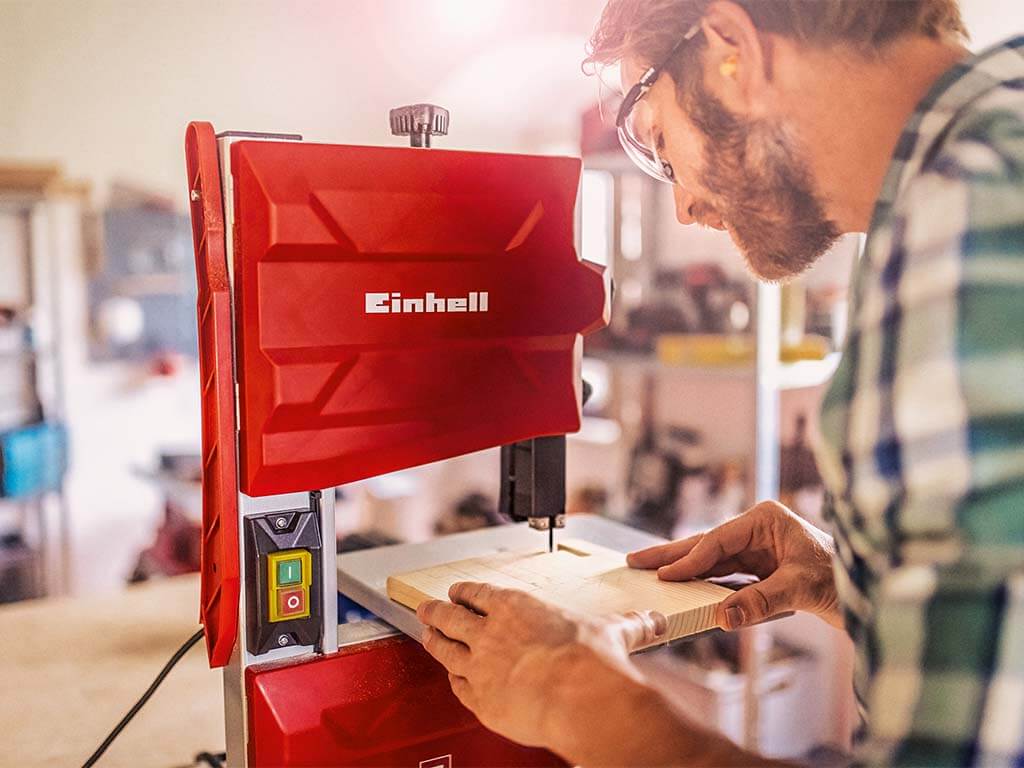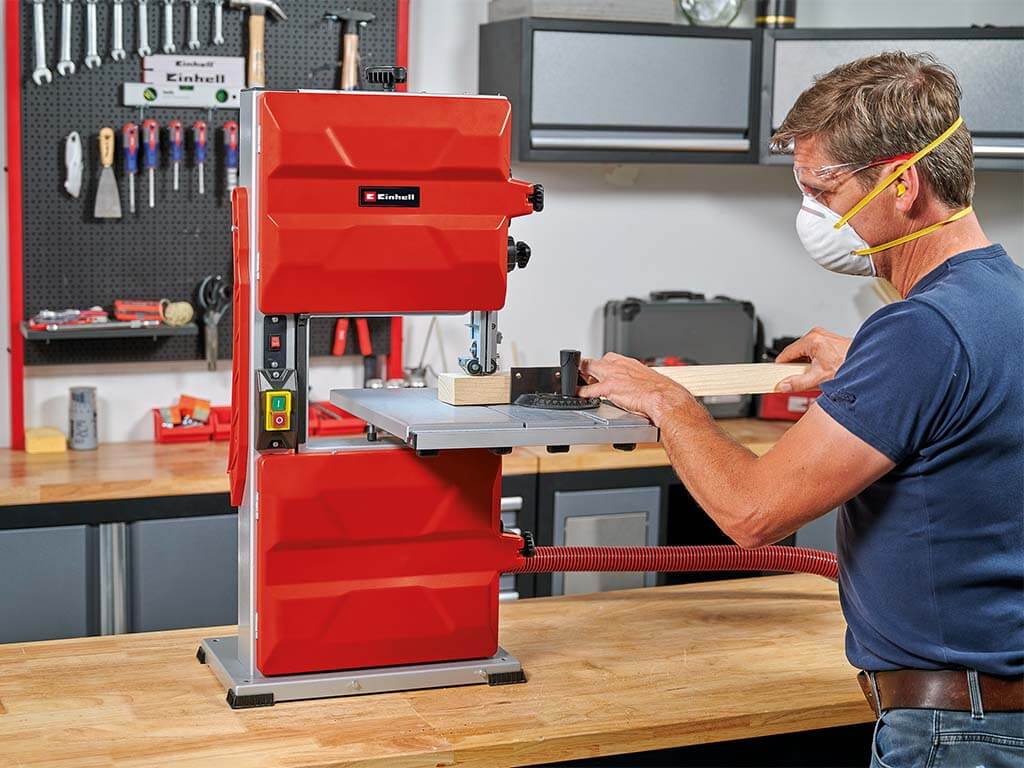Non‐stop sawing on the running belt – Einhell’s band saws in comparison
Whether its furniture, model making or decorative crafts – wood can be used to implement many projects in the home workshop. A saw that meets the most varied requirements is one of the must‐haves of every DIY enthusiast. The prime example of such an all‐rounder saw is the band saw, which can saw both coarse sawing work and filigree details. Since we subjected the Einhell bandsaw to our real‐life test, we explain in our blog what the band saw can do and why it is an enrichment for every DIY fan who likes to work with wood!
We have found out for you how the different models in the band saws test perform, what advantages they have compared to other saws and which model is best for you. But also how to make clean cuts, what you should pay attention to when handling your band saw and how to select the right saw blade, we explain below.

How a band saw works
The classic band saw is a semi‐stationary machine – it needs a place where it stands stable or can be attached to a chassis, depending on the model, but at the same time you can also place the machine elsewhere at any time if you are redesigning your workshop or simply do not need the band saw.
The operation of the band saw differs primarily in the way the saw blade runs, because unlike many other saws, the saw blade is not moved vertically up and down. In the band saw, a closed saw band is placed over two deflection rollers, so that the saw blade always moves from top to bottom and runs virtually in a circle. Ball‐bearing guides reduce the vibrations of the saw band, so that even precise cuts can be made with the band saw without any problems. If you work with a thin saw blade, you also work in a material‐conserving manner and have less material loss compared to other saws. With a height‐adjustable band saw guard, you can also regulate the passage height and adjust it perfectly to the size or thickness of your workpiece and material. The saw band protector additionally stabilizes the saw band.

The bandsaw in testing: Advantages compared to other saws
Do you already have different saws at home and both a hand‐held circular saw and a jigsaw are part of your workshop’s inventory? We tell you: It can still be worth buying a band saw, because the semi‐stationary machine is superior to other saws in some areas and scores with a wide range of applications. We have summarized the points for you:
- Versatile: The band saw proves to be a real all‐rounder! Whether straight and precise cuts, cross‐sections or circular, curved cuts – if you use the right saw blade, you have the machine with the band saw that makes all this possible.
- Mitre cuts: Mitre cuts are also no problem for the band saw thanks to the tilting work table. You can adjust the angle of the work table up to 45° and get started. The parallel guide can also be helpful here.
- Stationary machine: The band saw as a semi‐stationary machine also has the advantage that larger workpieces can be machined with it, because larger cutting heights can be achieved compared to the jigsaw. In addition, the workpiece does not have to be fixed first, as is the case with the hand‐held saw. Rather, the wood is simply guided through the machine.
- Fine sectional view: If you work with a thin and fine‐toothed saw blade, you can make very fine cuts with the band saw, which would not be possible with a hand‐held circular saw, for example.

Technical terms simply explained
You don’t have any experience with the band saw yet or are still considering buying one at all? For you to know what you should pay attention to in addition to a good price‐performance ratio when choosing your model, we will briefly explain the most important terms about band saws here.
Cutting height
The cutting height describes how high or strong the workpiece may be, so that you can still machine it with your band saw. The cutting height thus depends on how much „air“ there is between the work table and the guide rollers. That’s why the cutting height changes, for example, when you tilt the work table. You should also adjust the cutting height to your workpiece with the height‐adjustable saw blade guard, so that the saw blade is supported stably and the cut becomes straight.
Transmission width / projection
The passage width indicates the distance between the saw blade and the housing. The passage width thus depends, inter alia, on the size of the work table. So if you want to machine larger workpieces, because you are trying to make furniture, for example, you should choose a band saw with as large a passage width as possible.
Table Size
Actually, the table size is self‐explanatory, because it shows you the dimensions of the work table. The larger the work table, the larger the workpieces can be accommodated on it. The size of the table and the width of the passage are thus mutually dependent.
Cutting speed
The cutting speed, also often called saw band speed, describes how fast the saw band of your band saw runs. With the Einhell TC‐SB 305 U band saw, you can even choose between two saw band speeds.
Small or large band saw: This model is suitable for you
Minor works: TC-SB 200/1
The TC‐SB 200/1 Einhell bandsaw is our compact saw with 250 watt motor power. With a passage width of 200 mm and a maximum cutting height of 80 mm, it can be used for smaller jobs. Looking for a smaller model at a low price to practice working with the band saw? Then you are well advised with this saw!
Major projects: TC-SB 305 U
The TC‐SB 305 U band saw is best suited for large workpieces. With a passage width of 305 mm and a maximum cutting height of 170 mm, the model is perfect for woodworking for larger projects. With this model, you can also choose between two saw band speeds and optimally adapt them to the workpiece and material. The 750 watt machine is also equipped with a stable underframe.
Versatile: TC-SB 245 L
Between the large and small band saw, you will find our TC‐SB 245 L band saw. With 400 watts, it is not only in the golden middle in terms of motor power, the passage width of 245 mm and the cutting height of 101 mm ensure that the band saw is a good choice for machining medium‐sized workpieces. Thanks to the integrated LED light, you always have a good view of your workplace.
Practical equipment and accessories
- Parallel stop: As a guide for straight or long cuts
- Transverse stop: Practical tool for angle cuts
- Angle stop: To easily determine the cutting angle
- Extraction adaptor: For connecting an extraction device for a clean workplace and optimal visibility
- Push stick: For safe guidance of the workpiece and protection against injuries
- LED light: For optimal visibility of the workpiece, even in poorly lit areas

Correctly adjust band saw and saw blade
You will notice from the first installation of the band saw that the semi‐stationary machine is very complex. In order to work safely and precisely, it is important that you follow the enclosed operating instructions and proceed step by step. You should also know in advance that you have to adjust your band saw correctly after each saw blade change before you start with the next project. You will also find out exactly how to proceed when changing the saw blade and adjusting it in your instructions.
By the way: To use the band saw, you have to tighten the saw blade. When you have finished your work on the saw, you should loosen the saw blade again, because this not only protects the band saw blade, but also the tool.
The right blade for your application
- Curves and radii: The narrower or thinner the saw blade, the better you can cut narrow radii and curves.
- Straight cuts: Because thin saw blades tend to tear, it is better to use a wider or thicker saw blade for straight cuts.
- Fine sectional view: If you value a particularly fine cut, you should choose a fine‐toothed saw blade. This usually runs slower than coarse saw blades, but saws finer.
- Non‐ferrous metal: Finely toothed, hardened saw blades are best suited for sawing metal sheets. However, if your band saw is suitable for machining metals, you should read the operating instructions beforehand.
- Caution – Inappropriate material: Of course, as with almost every saw, there are also some materials in the band saw that you should not work with it. Magnesium, hard metal and hardened material, for example, are unsuitable for the band saw.

Summary: The bandsaw as an all-rounder in your workshop
For the processing of wood, the band saw is a machine that should find room in every hobby and home workshop! With our three models in different sizes and with different performance, you should be able to find the right machine for every hobby carpenter. With the right band saw blades at hand, nothing stands in the way of the work and the bandsaw becomes a practical all‐rounder for DIY work.











